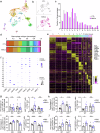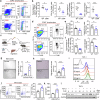Host FSTL1 defines the impact of stem cell therapy on liver fibrosis by potentiating the early recruitment of inflammatory macrophages
- PMID: 40050288
- PMCID: PMC11885662
- DOI: 10.1038/s41392-025-02162-6
Host FSTL1 defines the impact of stem cell therapy on liver fibrosis by potentiating the early recruitment of inflammatory macrophages
Abstract
Adult stem cell therapy holds great promise for treating decompensated liver cirrhosis on the basis of animal studies, despite uncertainty about its clinical therapeutic efficacy and unclear underlying mechanisms. Here, we investigated the role of follistatin-like 1 (FSTL1), a profibrotic and proinflammatory matricellular protein, in inflammation-related heterogeneity in stem cell therapy. Our results showed that a high level of circulating FSTL1 is significantly correlated with therapeutic response in patients with cirrhosis. FSTL1 facilitated MSC-mediated early recruitment of Ly6C+ inflammatory macrophages within 24 h postinfusion, which was essential for the empowerment of MSCs and subsequent Ly6C-CX3CR1+ macrophage remodelling at 48 h postinfusion. Fstl1 deficiency abrogated early macrophage recruitment and effective Ly6C-CX3CR1+ macrophage accumulation, resulting in the poor antifibrotic effect of MSCs in mice. Whereas, recombinant FSTL1 protein restored the therapeutic efficacy of MSCs in CCl4-injured Fstl1+/- mice. Mechanistically, host FSTL1 enhanced rapid recycling of CCR2 to the membrane via activation of the CD14/TLR4/NF-κB/ATP6V1G2 axis, leading to early recruitment of Ly6C+ monocytes /macrophages. Taken together, our findings revealed that FSTL1 is a critical regulator of the fibrotic immune microenvironment and facilitates subsequent stem cell therapy. These data suggest that FSTL1 could serve as a predictive biomarker of stem cell therapy response in patients with liver cirrhosis.
© 2025. The Author(s).
Conflict of interest statement
Competing interests: The authors declare no competing interest.
Figures








References
-
- Ramachandran, P. & Henderson, N. C. Antifibrotics in chronic liver disease: tractable targets and translational challenges. Lancet Gastroenterol. Hepatol.1, 328–340 (2016). - PubMed
-
- Coilly, A., Roche, B., Duclos-Vallée, J.-C. & Samuel, D. Optimum timing of treatment for hepatitis C infection relative to liver transplantation. Lancet Gastroenterol. Hepatol.1, 165–172 (2016). - PubMed
-
- Lee, C. W., Chen, Y. F., Wu, H. H. & Lee, O. K. Historical perspectives and advances in mesenchymal stem cell research for the treatment of liver diseases. Gastroenterology154, 46–56 (2018). - PubMed
MeSH terms
Substances
Grants and funding
- 82270551/National Natural Science Foundation of China (National Science Foundation of China)
- 81900570/National Natural Science Foundation of China (National Science Foundation of China)
- 82303155/National Natural Science Foundation of China (National Science Foundation of China)
- 82372882/National Natural Science Foundation of China (National Science Foundation of China)
LinkOut - more resources
Full Text Sources
Medical
Research Materials
Miscellaneous

